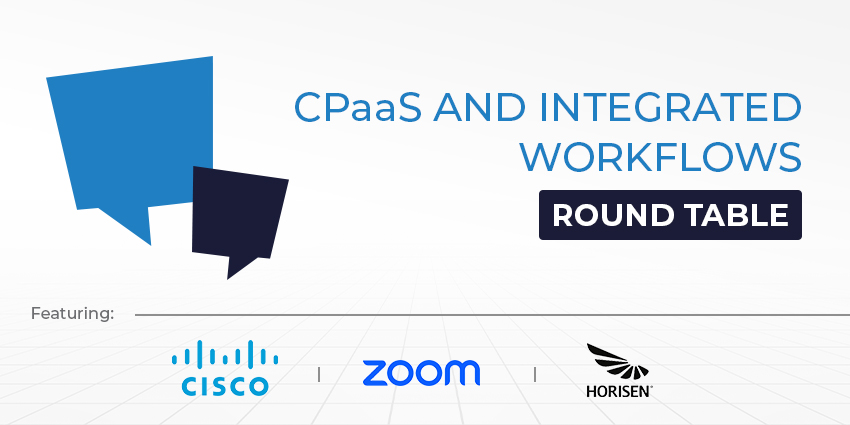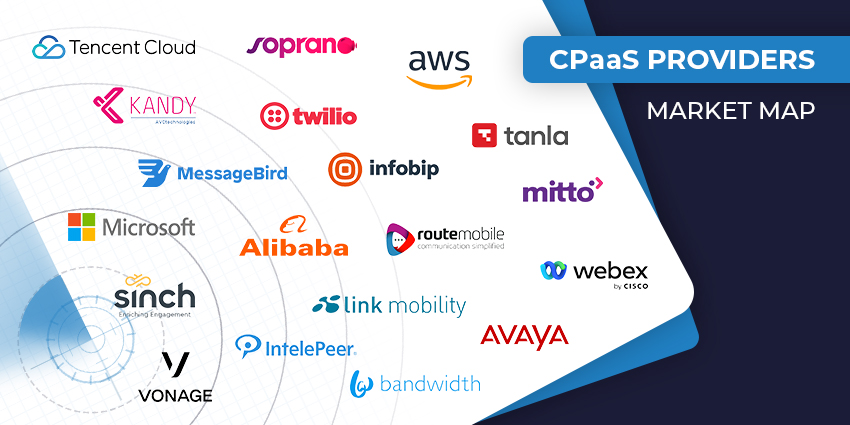What is CPaaS, and why is it such a compelling option for companies looking to upgrade their communication stack? Designed to address the needs of business leaders with flexible communication capabilities, CPaaS leverages cloud technology and APIs.
A CPaaS platform provides companies with a convenient, easy way to retrofit their existing apps and workflows with new communication channels, technologies, and innovative tools.
In a world where communication strategies are evolving at an incredible rate, CPaaS allows companies to develop real-time communication (RTC) tools they can embed into their proprietary apps and software. You don’t need to be an expert programmer to invest in the landscape either.
Let’s take a closer look at the CPaaS landscape, and the benefits of CPaaS platforms.
What is CPaaS? What Does CPaaS Mean?
To answer the question “What is CPaaS,” we first need to define “PaaS,” or Platforms as a Service. CPaaS is a “PaaS” service delivered through the cloud. It allows companies to build and deploy applications into various environments without dealing with underlying infrastructure.
Companies manage data with a “PaaS” solution, while the platform provider handles things like servers, storage, and hardware.
CPaaS simply focuses on “communication platforms.” CPaaS vendors provide communication infrastructure for businesses to use, while developers in a business build custom applications or use APIs to add new communication features to existing apps.
The communication capabilities offered by APIs empower companies to build their own truly omnichannel technology stack. Companies can embed MMS, SMS, telephony, video, and chat features into their tools. Communication services like notifications, click-to-call capabilities, and multifactor authentication are also available from CPaaS vendors.
The platforms market leaders offer use comprehensive software development kits, Java and .NET libraries, and standards-based APIs to empower developers. Some providers also offer bundles of tools that provide access to fully-functional, pre-packaged communication features.
What is CPaaS? How Does CPaaS Work?
The purpose of CPaaS is to allow companies and developers to add real-time communication features to existing applications. Instead of using pre-built tools for communications, such as Microsoft Teams, companies can leverage APIs to add the features they need, such as SMS or video calling, to their existing tools.
Examples of communication capabilities offered by a CPaaS vendor can include the following:
- SMS (Short message services)
- MMS (Multimedia messaging services)
- VoIP and Voice
- Teleconferencing and video
- Social media (WhatsApp, Facebook Messenger, etc)
- Chatbots and messengers
- RCS (Rich Communication Services)
- Authentication and security features
CPaaS service providers provide in-house developers with standards-based APIs, pre-built applications, and sample code to ensure they can access the needed functions. After APIs are built into an existing application, they can request, send, and receive information between servers.
Enterprise leaders can choose which CPaaS APIs they want to use, and customize their functionality to address specific needs. For instance, an airline could use an SMS API to automatically update customers on flight times.
Usually, users are billed every month for the API requests they access within a CPaaS platform. However, this is often a lot cheaper than developing and managing an app in-house.
While companies can offer comprehensive kits to help businesses leverage these services, they often require a small amount of technical knowledge. Some companies may outsource processes to a developer, system integrator, or CPaaS consultant.
Types of CPaaS Solutions
CPaaS providers can take different approaches to providing a solution for their customers. Some offer white-glove co-creation services, with included developmental support. Others provide access to a library of SDKs, APIs, and tools that developers can access as needed.
Some of the most common types of solutions include:
- Ready-to-use kits: Companies offering ready-to-use solutions use pre-built codes, applications, and packages to offer access to communication features instantly. These tools are often optimized for specific use cases and may offer fewer customization options.
- Modular solutions: Modular CPaaS vendors, such as Twilio, Nexmo, and Pilvo, allow companies to take advantage of the specific communication APIs and features they need. They can specialize in specific solutions, like SMS, A2P, and P2A APIs, or offer various APIs and modules.
- Co-creation services: For companies without their development team, some vendors can offer co-creation models, which aid with development, API creation, implementation, and management.
CPaaS providers can also come from various backgrounds, from traditional enterprise communication vendors to specialist API experts.
CPaaS vs. UCaaS: What’s the Difference?
UCaaS is often seen as a similar solution to CPaaS, though there are some core differences between the services. Both offer access to cloud-based communication systems. However, CPaaS uses APIs to allow companies to build any tool they need and integrate it with existing platforms.
UCaaS, on the other hand, consolidates communication services into a single, ready-to-use platform. This makes UCaaS a good choice for companies searching for a straightforward communication platform. Alternatively, CPaaS is better suited to companies looking for flexibility and customization options when building a communication stack.
Notably, some UCaaS providers are now investing in combining their offerings with other as-a-service solutions. Vendors like Vonage and RingCentral offer access to both UCaaS and CPaaS solutions to allow for greater flexibility.
Some organizations even combine UCaaS, CPaaS, and CCaaS to provide businesses with a comprehensive cloud-based environment for communications.
What is CPaaS Used For?
CPaaS makes it simple for companies to adapt their communication stack and adhere to customers’ needs in a changing marketplace.
Historically, introducing new services to a system required additional resources, a more complex and expensive infrastructure framework, and new hardware. Today, the cloud-based CPaaS approach offers businesses more flexibility in deploying and paying for digital engagement solutions.
The communication services CPaaS solutions can provide cover everything from outbound voice calls to inbound call routing, WebRTC-based calling, text messaging, and even on-demand SIP trunking.
Some vendors can also offer access to social media messaging integrations, multimedia and video messaging tools, and security solutions like multi-factor authentication and number masking.
The versatility of the CPaaS landscape makes the solution appealing to a wide range of companies, from a host of industries. Some potential use cases for other sectors include:
Healthcare:
In the healthcare industry, companies can use CPaaS solutions to implement real-time communication tools into the apps used by patients, doctors, and clinical staff. It’s even possible to use CPaaS to embed real-time notifications and alerts into systems to keep crucial team members informed on the move. For instance, a monitoring device could instantly alert a doctor when a patient deteriorates.
Retail:
In the retail industry and ecommerce landscape, companies can use CPaaS tools to keep customers up-to-date on orders with automatic texts. They can push sales messages to phones based on a customer’s location and other triggers. Companies can use the technology to build and implement loyalty programs to increase sales and audience engagement.
Hospitality:
In the hospitality industry, CPaaS can help companies to improve collaboration between forward-facing and back-office teams. CPaaS solutions can also allow for two-way communications with customers, allowing clients to check into locations remotely.
Banking:
CPaaS solutions in the banking sector can help keep clients notified with alerts about their account status. They can also improve banking security. For instance, organizations could use CPaaS to implement multi-factor authentication and other security tools into their apps.
Government and Public Services
In the government landscape, CPaaS allows groups to create apps to interact consistently with citizens. Authorities can use CPaaS to deliver emergency SMS alerts to large groups of residents automatically. Or they could provide customer service to citizens through messaging, video, and voice apps.
The CPaaS Market: Who are the most prominent CPaaS players?
The CPaaS market is growing at an exceptional rate. The landscape is set to reach a value of $172.91 by 2031, growing at a CAGR of 31%, and new players are constantly getting involved.
Similar to many as-a-service communication and software platforms, the growth of CPaaS has been attributed partially to the impact of the pandemic.
Companies looking for ways to rapidly grow and expand their communication strategies to adhere to new customer expectations and work styles are investing in CPaaS for flexibility and agility.
Initially, the market was primarily driven by startup technology companies, such as Plivo and Twilio. However, legacy unified communication vendors have begun to enter the market, too, with new services and solutions. Some vendors, like Vonage, have even acquired other companies (Nexmo) to expand their capabilities.
Find a complete guide to leading CPaaS vendors in 2023 here.
What is the benefit of CPaaS? CPaaS benefits
The flexibility of Communication Platforms as a Service makes them exceptional at addressing various enterprise communication and technology needs. Perhaps the most significant benefit of CPaaS is it allows companies to access real-time communication capabilities without having to build and manage complicated infrastructure in-house.
However, CPaaS also has other distinct benefits, such as:
Cost reductions
CPaaS platforms are cloud-based solutions which reduce the need for companies to set up and manage their infrastructure. Many platforms allow organizations to pay only for the features and services they use, reducing overhead expenses.
What’s more, if the apps used connect employees, this can lead to increased efficiency and productivity. Boosted efficiency in the workplace often reduces internal costs.
Enhanced customer experiences
CPaaS ensures you can communicate with customers through their preferred channels. An excellent customer experience leads to increased sales, loyalty, and opportunities.
Companies can create a highly personalized customer experience through text, video, voice, and rich messaging. They can invest in strategies for meaningful engagement, automatically sending customers coupons, offers, and abandoned cart reminders.
Stronger security
CPaaS solutions can allow companies to add more security to their processes and communications. Today’s vendors offer options for phone number authentication and verification, two-factor authentication, and more.
The right solutions can also help to keep employees and customers informed of threats, with automatic alerts triggered by potential risks.
Agile Deployment
With CPaaS, companies of any size can rapidly invest in the latest innovative technology. APIs make it quick and simple to develop and deploy real-time communication features like video, voice and messaging into any enterprise applications.
What’s more, by removing the need to own and manage hardware, CPaaS allows companies to upgrade their technology in just a couple of days.
Customization
Unlike standard UCaaS platforms, which come with pre-set capabilities, CPaaS solutions give businesses complete freedom over the tools they want to implement. There’s no need to settle for one-size-fits-all. Every company can completely customize their communication channels to fit their budget, strategies, capabilities, and CX needs.
Scalability
As well as being highly customizable, these platforms are fully scalable. You can add or remove features without any hassles. If you decide you want to add new features to your app or service at a later date, you can do so without having to start from scratch.
This makes CPaaS a solution that can continue to promote improved growth and progress for your business. You’ll never have to worry about whether you can meet with changing industry demands.
Better Internal Operations
Alongside improving customer-facing communications, CPaaS can help to improve employee communications too. You can ensure you keep everyone your team informed with company-wide alerts, or send individual messages to different teams.
APIs can even improve work safety, informing teams about security incidents, emergencies, and threats in the workplace.
Getting Started with CPaaS
Now you know the answer to “what is CPaaS?” you might be keen to get started with your own strategy. The easiest way to dive into the CPaaS market is to choose the right vendor. A few points to think about when making your decision include:
- API options and quality: Look for vendors with a variety of API options, and technology that has been tested for reliability and stability.
- Complexity: Some vendors offer wrappers and modules that help companies with limited coding skills.
- Developer community: A strong user community can help businesses learn how to properly implement each tool.
- Network infrastructure: Ensure your vendors can offer reliable and consistent service for all kinds of communication methods.
- Data security: Make sure the right security methods are available to protect valuable data shared through communication apps.
Once you have the right vendor, you’ll be able to work with them to evolve your communication strategy, with an agile CPaaS platform.







